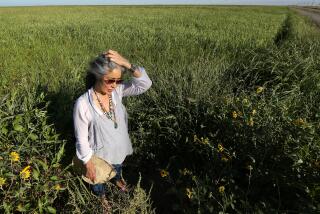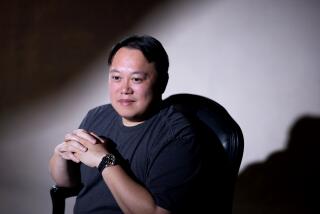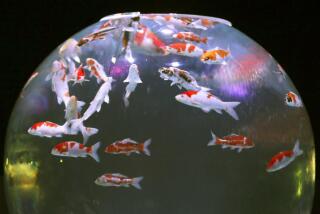They’re Only Good for 1 Thing--to Look At : Fish Collectors Pay a Hefty Price for Tranquility of Colorful Koi
- Share via
If you want to get under Bill Ward’s skin, really make him grit his teeth and turn testy, just call them “those big goldfish.”
Goldfish? Hardly.
These fish, which Ward helps raise on a pond-dotted parcel in the rolling hills of Fallbrook, can sell for up to $150,000. They’re nurtured like prized racehorses. If they’re ill, surgery is sometimes performed. Some have been known to live more than 200 years.
No, these aren’t something you pick up at a dime store. They’re koi, a Technicolor variety of fish long revered and raised in stone-lined ponds in the Orient.
In recent decades, the multihued fish have become a collector’s delight in the United States, and a major center of breeding and rearing activity is the 10-acre farm that Ward manages in Fallbrook.
One of Nation’s Largest
California Koi Farms Inc., one of the largest firms in the United States devoted exclusively to koi, has been in operation since 1974, when Yoshihiko Adachi started the business as an offshoot of his fish farm in Yonago, Japan.
In Japan, the raising of koi (pronounced coy) is something of a national pastime. The fish, a type of carp that can grow to more than 3 feet in length, are prized for their spectacular colors, ranging from brilliant reds and golds to electric yellow, blue and black.
Many of the koi found in the United States are relatively common-looking, orange-hued fish populating concrete ponds at
hotels and restaurants. Nonetheless, the number of aficionados collecting the more prized varieties, which seem to span the colors of the rainbow, has grown.
“Koi keeping can be the most expensive hobby in the world,” Ward said one recent afternoon as he led a tour of the farm. “A $100,000 fish is good for one thing and one thing only: to look at.
“But you’re dealing with something living. It’s not like a painting. You can have a championship koi, and someone comes along and flips a cigarette into the pond. Whammo! You’re out a $100,000 fish.”
Koi Clubs Started
In California and other states, numerous koi clubs have popped up in recent years. Fish shows are held regularly, with trophies and prestige showering the finned champions in each of more than a dozen different categories broken down by color or pattern.
The Fallbrook-based koi farm has been able to tap the growing popularity.
Since it opened, the farm has been run by Adachi’s son, Takemi, who supervises breeding and most other aspects of the operation. Now 31, the younger Adachi began working with koi at the age of 14 and was fully responsible for the business at 16.
Adachi’s family decided to open the farm in Fallbrook largely because of its proximity to the large Japanese community in Los Angeles and two major airports for shipping the fish.
An erstwhile chicken ranch, the acreage is now pockmarked by two dozen earth-bottomed ponds, some of them more than 100 feet across. The murky waters are filled with hatchlings and other small koi. Several rows of cement tanks used for display stretch along another section of the property.
There is nothing high-tech about the operation. Though the water in the display tanks is kept clear so visitors can inspect the fish, the earthen ponds are left purposely murky, providing the small koi with the best environment to grow up in.
The murky water also helps shroud the koi from herons, egrets, hawks and other birds of prey, which are always a threat.
Breeding the fish is a time-consuming process. Each koi is carefully selected for breeding by Takemi Adachi based on the colors and patterns he senses will be produced in the offspring. The best fish have well-balanced patterns and vivid colors.
300,000 Eggs
A female koi lays up to 300,000 eggs. The fish that survive to reach an inch in length are herded with a fine-mesh net into a corner of the pond, where Adachi sets about the painstaking task of selecting the best koi to keep. He sits down with a pail full of fish, using a tiny net to sort out the best from the rest. Only one of 10 fish make the cut.
As the koi mature, this culling process is performed several times, until the farm has a stock of only the finest fish left for sale, according to Ward, who has managed the Fallbrook operation for six years. The result, he boasts, is “the best koi in the United States, bar none.”
When the fish are big enough, Ward and Adachi pull in a load. The catch is transferred to holding tanks where they can gradually adjust to clearer water conditions, a process that takes several days. In addition, the water is often medicated to ensure the health of the fish. Ultimately, the koi are loaded into the crystal-clear display tanks, where they can be plucked out with a net for a customer who stops by or be shipped by plane across the country.
Indeed, koi are top-notch mail-order fish. But shipping a fish cross-country is not a small feat.
Koi ranging from small fry to big whoppers are placed in clear plastic sacks filled with a few gallons of water. Each sack is then inflated with pure, medical-grade oxygen (koi are one of the few fish capable of gulping air) and tucked inside a cardboard box for shipping.
Fish Travel Well
Despite the Spartan conditions, the fish travel quite nicely, and it’s been a rare occasion when one has been lost, Ward said. For orders over $1,000, pictures are sent to prospective owners in advance of the fish being shipped. Few customers have been disappointed, Ward said.
Though the fish typically survive 20 to 40 years in a concrete pond in the United States, koi have been known to live for centuries in Japan, where the water is more pure and owners tend to pamper their pets, Ward said.
“In Japan, 100 years is not uncommon,” Ward said. “We call them three-generation fish: You find them and the grandkids bury them.”
In the United States, koi owners come from “all walks of life,” despite the high price-tag for the top fish, Ward said. Many people buy the fish at an early age, hoping to snag a future champion before the cost skyrockets too high.
Economics aside, Ward suggests that koi have a profound, almost medicinal effect on the psyche.
“You go out to watch your fish for 10 minutes and you’ll blow an hour,” he said. “They’re very relaxing. It’s the fluid movements of the fish. It’s graceful and it’s smooth. You can get high on koi.”
More to Read
Sign up for The Wild
We’ll help you find the best places to hike, bike and run, as well as the perfect silent spots for meditation and yoga.
You may occasionally receive promotional content from the Los Angeles Times.






